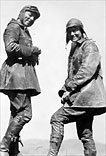 Text by Robert Van Buren, photos from the Van Buren Family Collection
Text by Robert Van Buren, photos from the Van Buren Family Collection
Pioneering women motorcyclists Augusta and Adeline Van Buren rode coast to coast on Indian Power Plus motorcycles in 1916, becoming the first women to ride motorized vehicles to the summit of Pikes Peak along the way. Part of their mission was to convince the military that women were fit to serve as dispatch riders. And although they did not achieve that goal, they clearly proved that women were capable of far more than society generally allowed them in that era.
Augusta was born March 26, 1884, and Adeline was born July 26, 1889. Descendents of former President Martin Van Buren, the sisters were slender "society girls" out to prove that women could ride motorcycles across the then-treacherous continent, even though they still did not have the right to vote.
The sisters were raised in New York City along with their brother, Albert, and enjoyed an energetic upbringing characterized by canoeing, swimming, skating, diving, wrestling, and sprinting. It’s not surprising that they also took up motorcycling.
Their lives were marked by a series of accomplishments. They were bright, enthusiastic, and refused to be held down by the limitations that society placed on women of that era.
Being intelligent young women, they prepared for their transcontinental journey carefully. Their intent had a dual purpose. The National Preparedness Movement was an effort to get ready for the inevitable entry of the United States into World War I. Augusta and Adeline felt that women could help in a direct manner by becoming dispatch riders, freeing up men to provide combat support. This would remove one of the primary arguments for denying women the right to vote – women were historically non-participants in war efforts. They would have to prove this point by showing, without a shadow of a doubt, that a woman could handle the difficulties of motorcycling over long distance and harsh conditions. Thus, before superhighways, and paved roads for the most part, their plan was conceived.
First, they incrementally accumulated long distance rides in New York, and then set off on their journey on July 4, 1916. They left from Sheepshead Bay in Brooklyn and trekked west through Chicago and Omaha aboard their Indians equipped with gas headlights. The Power Plus was the model with the “webbed vanadium steel Cradle Spring frame,” Indian’s top of the line bike in that period, selling for $275. They also ran with Firestone tires, and enjoyed success with both the bikes and the tires.
The journey got difficult, especially since they were arrested numerous times in the small towns west of Chicago, not for speeding but for wearing men’s clothes. They were dressed in leathers, and after reaching an understanding with the law, they were allowed to push on with their trip.
Technical difficulties were encountered in crossing both the Rockies and the western deserts. The sisters were the first women to summit Pike’s Peak on any kind of motorized vehicle. The road to the summit was dangerous, rising to 14,109 feet, but for Gussie and Addie it was just another challenge. Next they headed west out of Colorado Springs, through Gilman and on to Grand Junction. They fell off their bikes many times, the result of fatigue, ruts, or in some cases, heavy mud. The locals often would come to their aid, retrieving their bikes if they were inextricably stuck.
They arrived in San Francisco on September 2 after some hazardous experiences in the deserts west of Salt Lake, including nearly running out of water. They completed their journey on September 8 after arriving in Los Angeles. Just for good measure, they decided to continue to Tijuana for a final crossing of the border.
After this series of accomplishments, and after proving their competence, Adeline’s application to the military as a dispatch rider was rejected. The coverage in the media of the day, although adequate in many respects, lacked the recognition that they had earned and so rightfully deserved. Articles in the premier motorcycling magazine of the day praised the bike, but not the sisters. Their historical achievement was described as a vacation, rather than the pilgrimage that it was.
Both Augusta and Adeline eventually married and pursued their lives. There is little evidence about whether they continued riding, but they did continue to be pioneers. Adeline, initially an English teacher, eventually earned her law degree from NYU. Augusta became a pilot, flying with the women’s flying group founded by Amelia Earhart, called the 99s.
Augusta and Adeline Van Buren broke the stereotypes of their time proving that woman could do anything a man could do. In the words of Augusta, “Woman can if she will.”
They were inducted into the AMA Motorcycle Hall of Fame in 2002.